Cooking with edible oils: Part II, Cooking thru oil-mediated heat transfer
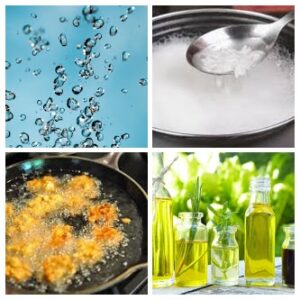 Oil and water as cooking media – nature’s amazing scheme: Oils and water are the only two liquids in our food-life against a slew of solids. The comparison between ‘boiling in water’ and ‘frying in oil’ has been touched upon in the last post. The divergent characteristics of water and edible oils hide an amazing natural scheme that makes all cooking possible. There is hardly any served dish in which both don’t have role and are not a part of. Exceptions: plain boiled rice and plain khichadi among staples; interestingly, they turn delights with ghee. Note: gelatinized rice starch in both is a partial fat mimic; it is smart to prefer loose, moist slightly gooey dishes that ‘play up’ the added ghee rather than dry dishes with separate grains.
Oil and water as cooking media – nature’s amazing scheme: Oils and water are the only two liquids in our food-life against a slew of solids. The comparison between ‘boiling in water’ and ‘frying in oil’ has been touched upon in the last post. The divergent characteristics of water and edible oils hide an amazing natural scheme that makes all cooking possible. There is hardly any served dish in which both don’t have role and are not a part of. Exceptions: plain boiled rice and plain khichadi among staples; interestingly, they turn delights with ghee. Note: gelatinized rice starch in both is a partial fat mimic; it is smart to prefer loose, moist slightly gooey dishes that ‘play up’ the added ghee rather than dry dishes with separate grains.
Characteristics that make oils a cooking medium: (i) Low volatility – no vaporization at cooking temperatures, (ii) high interfacial tension with water – immiscible, (iii) low chemical reactivity if cooking is smart – we will come to that shortly, (iv) varied physiological and physical functionalities (ref post nos. 18 and 19 for functionalities of oils/fats inside and outside our body), (v) culinary and aesthetic appeal of oil-cooked products. Our cooking methods exploit one or more of these characteristics and how oil mediates in each is fascinating, as we glimpsed in the previous post.
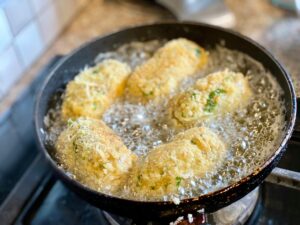 In this post, we focus on frying – essentially cooking thru oil-mediated heat transfer. (Caution: As a general rule, higher temperatures accelerate all chemical reactions and oxidative damage to double bonds in oils is a chemical reaction.) Obviously, since this happens thru direct contact, oil inevitably becomes a part of food and has some ingredient and physiological functionalities as well. Note that frying is made possible by oil’s immiscibility with water which enables it to let escaping water or steam pass thru oil without messing with it.
In this post, we focus on frying – essentially cooking thru oil-mediated heat transfer. (Caution: As a general rule, higher temperatures accelerate all chemical reactions and oxidative damage to double bonds in oils is a chemical reaction.) Obviously, since this happens thru direct contact, oil inevitably becomes a part of food and has some ingredient and physiological functionalities as well. Note that frying is made possible by oil’s immiscibility with water which enables it to let escaping water or steam pass thru oil without messing with it.
A primer on oil-mediated high temperature cooking: Home-made pickles, chutneys, fruit and vegetable salads, juices for immediate consumption, instant sherbets and powdered plain and compounded spices are the only dishes that do not require heat. But they don’t have the cooking feel, do they? Somehow, a cooked dish has to have been exposed to heat. Interestingly, billowing of cooked roti on direct flame and flame-roasting of papads, Rajasthani bati and aubergine/brinjal/egg plant are the only cooking ways that expose the food directly to flame. Corn roasted on direct fire is similar but not a mainstream dish. Note: (i) Papads have practically no moisture, bati has moderate amounts and aubergine, about 80 % and their stay on the flame is proportionately long! Long duration of roasting of aubergine (baingan) is rendered safe by evaporating water which limits the temperature to a safe limit; do knock off all burnt skin. Papads turn black quickly on roasting and bati hardens and browns up a little slowly.
In all other ways, application of heat is indirect i.e. the flame transfers the heat to the vessel / wok / griddle / skillet / steam cooker which transfers it to the food being cooked thru intermediation of water or oil.
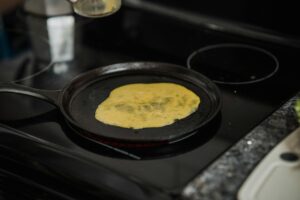 Treating all oil-mediated heat transfer cooking as frying: When oil helps transfer flame heat to the food, the oil:food proportion can vary from near equal (deep frying) to practically no oil (pan cooking of flats on oil films). But in all cases, oil is taken up by the food (and becomes a part of served dish) and both change – visually, chemically and taste-wise. Hence we will treat all such uses of oil as ‘frying’ even if making a chilla or uttapam on an oiled hot plate may not, prima facie, look like frying. Note, however, that treating the oil as merely a heat transfer medium is an engineering construct. In reality, the inevitable oil-food interactions during frying help develop texture, flavor and a certain aftertaste which the food technologists like to treat as ‘functions that oil and frying perform’.
Treating all oil-mediated heat transfer cooking as frying: When oil helps transfer flame heat to the food, the oil:food proportion can vary from near equal (deep frying) to practically no oil (pan cooking of flats on oil films). But in all cases, oil is taken up by the food (and becomes a part of served dish) and both change – visually, chemically and taste-wise. Hence we will treat all such uses of oil as ‘frying’ even if making a chilla or uttapam on an oiled hot plate may not, prima facie, look like frying. Note, however, that treating the oil as merely a heat transfer medium is an engineering construct. In reality, the inevitable oil-food interactions during frying help develop texture, flavor and a certain aftertaste which the food technologists like to treat as ‘functions that oil and frying perform’.
A relatively high boiling, almost saturated liquid hydrocarbon ( e.g. mineral oil, soft grease) would mimic oil-frying but the product would have poor consumer appeal apart from the illegality of making a non-edible ingredient – the mineral oil – a part of an edible dish. (You are aware that such mineral oil or paraffin is sometimes used as a laxative – a lot like the inedible castor oil.) Note how unscrupulous road-side halwai’s adulterate frying oil with mineral oil to lower the cost of oil and make extensive frying possible without much oxidative damage to oil or the appeal of the fried dish. (Ref post no. 18, Edible oils have many roles outside our body: The non-physiological functionalities of edible oils).
 The universal appeal of fried products: Fried dishes and foods are probably the most enticing of all and we instinctively feel that potato chips/wafers and ‘French fries’ among them, must be the most popular worldwide. Fried chicken, potato chips and French fries in America, pakode/samosa/kachaudi/puri in the Indian subcontinent and tempura in Japan clinch the popularity of frying worldwide because all three categories have spread far and wide.
The universal appeal of fried products: Fried dishes and foods are probably the most enticing of all and we instinctively feel that potato chips/wafers and ‘French fries’ among them, must be the most popular worldwide. Fried chicken, potato chips and French fries in America, pakode/samosa/kachaudi/puri in the Indian subcontinent and tempura in Japan clinch the popularity of frying worldwide because all three categories have spread far and wide.
Deep frying: This is the classical immersion frying (in batches at home with oil remaining the same unless replenished midway), also called ‘deep fat frying’. ‘Fat’ may have come from the fact that low IV fats like hydrogenated oils, palm oil, lard and tallow (solid-ish at room temperatures), which can withstand the high temperatures and exposure to atmospheric oxygen, were originally preferred. (Ref post 17: Edible oils, an introduction for the superfluous oil-fat distinction).
The major con against low IV fats is that the fried product can become greasy to touch and in mouth-feel at low temperatures because of solidified fat. Palmolein – the fluid fraction physically separated from palm oil – has made deep inroads into industrial frying applications worldwide because of its relatively low IV (and oxidation resistance), low linolenic-linoleic content and non-greasy feel. Deep frying conjures up images of something immersed in hot oil, surrounded by a profusion of bubbles and tossed about by a ladle.
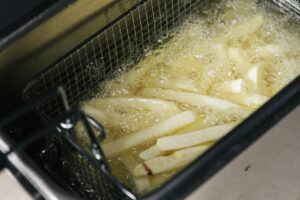
Frying at home is both an art and science and frying quality is determined by the nature of oil and the time-temperature combination; stirring or tossing remain an accepted common requirement. The following are the fundamental considerations: 1. The water/moisture-content of what is being fried. 2. The composition of the non-water part. 3. The final form expected in terms of flavor, crispness/moistness and color. 4. Shelf-life expected. 5. Oil available – we will take up the best oils for frying soon. 6. Insight in how a large fraction of flame heat is modulated to reach the item in the oil bath to bring about the just-right extent and type of fry-cooking.
 The mechanism of deep frying is fascinating. Note the heat transfer pathway: flame to a couple of mm of conductive metal thickness to a pool of convectively heated viscous liquid to the food surface to the food core. The oil, in direct and intimate contact, heats up the item quickly raising its temperature and vaporizing water and miscellaneous volatiles. Simultaneously, starch gets gelatinized (water trapped between its long strands – ref the posts on diabetes), some Maillard Reaction (inevitable browning because of reaction between proteins and sugars at high temperatures) and caramelization of carbohydrates occur. (Ref post no. 15, Oxygen, food and life: Part I). This is most of it though, not all. These contribute to development of brownishness and a typical frying flavor reminiscent of slight burning. Interestingly, all equal-sized bits being fried receive heat from the oil at practically the same temperature, hence uneven frying is rare as long as input to and output from the pan are timed smartly.
The mechanism of deep frying is fascinating. Note the heat transfer pathway: flame to a couple of mm of conductive metal thickness to a pool of convectively heated viscous liquid to the food surface to the food core. The oil, in direct and intimate contact, heats up the item quickly raising its temperature and vaporizing water and miscellaneous volatiles. Simultaneously, starch gets gelatinized (water trapped between its long strands – ref the posts on diabetes), some Maillard Reaction (inevitable browning because of reaction between proteins and sugars at high temperatures) and caramelization of carbohydrates occur. (Ref post no. 15, Oxygen, food and life: Part I). This is most of it though, not all. These contribute to development of brownishness and a typical frying flavor reminiscent of slight burning. Interestingly, all equal-sized bits being fried receive heat from the oil at practically the same temperature, hence uneven frying is rare as long as input to and output from the pan are timed smartly.
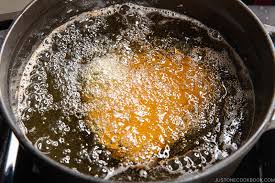 What happens during frying: The ‘channels’ thru which the vapors escape (causing the all-too-familiar bubbling or effervescence and some ‘fluff-up’ of the dish) invite the hot oil to ingress. (Note that the outward flux of the vapor stops quickly enough.) Obviously, high moisture batters tend to intake more oil which the home-maker calls ‘burning of too much oil’. But oil doesn’t burn; it just gets caught up. The nuances of frying specific varied items like high moisture batters, gulab jamun, dahi vada, South Indian vada, dry nuts and ‘crisps’ etc make a fascinating study blurring the boundary between culinary art and food science and deserve a separate post. But the central insight is: oil is a direct contact heat transfer medium which changes chemically and physically during frying and becomes a part of the dish/product which also changes.
What happens during frying: The ‘channels’ thru which the vapors escape (causing the all-too-familiar bubbling or effervescence and some ‘fluff-up’ of the dish) invite the hot oil to ingress. (Note that the outward flux of the vapor stops quickly enough.) Obviously, high moisture batters tend to intake more oil which the home-maker calls ‘burning of too much oil’. But oil doesn’t burn; it just gets caught up. The nuances of frying specific varied items like high moisture batters, gulab jamun, dahi vada, South Indian vada, dry nuts and ‘crisps’ etc make a fascinating study blurring the boundary between culinary art and food science and deserve a separate post. But the central insight is: oil is a direct contact heat transfer medium which changes chemically and physically during frying and becomes a part of the dish/product which also changes.
An interesting fact: the hazard of allowing oil to be heated to frying temperature in contact with atmospheric oxygen, is real and hence be alert. Always start heating the oil only when your frying inputs are ready. As soon as the temperature is reached (practiced feeling of the heat by holding a palm a couple of inches from the oil surface works), start frying. During frying of batters and high moisture vegetables like potatoes, the risk is reduced by the vapour flux leaving the oil/air interface pushing the air away, in the initial stages.
As frying proceeds, this flux reduces quickly, inevitably increasing the air hugging oil i.e. the oxygen partial pressure close to hot oil surface, increases. The double whammy is: the item in the oil bath is also now drier than before exposing more and more of oxidizables to increasing oxygen. Smart frying (‘coming soon’) can reduce but not eliminate it. But working out your own understanding of the variation in oil’s temperature during a frying batch and how best to manage it by timing frying inputs and drawals and flame modulation is fascinating.
A conceptual heat ‘balance’: Total exothermic heat of combustion of the cooking gas = heat absorbed by the vessel + heat absorbed by the oil + heat absorbed by the food + heat of vaporization of water and volatiles + heat lost in escaping flue gases + heat lost to surroundings from all intermediaries.
Therefore, a mathematical model for frying heat for a multi-batch operation at home, taking time ∆t (frying oil neither replenished nor withdrawn):
Exothermic heat of combustion of the cooking gas = heat required to heat the vessel and oil from room temp to final (i) + heat transferred to the item to raise its temperature (ii) + heat required to raise and expel vapours (iii) + heat lost to surroundings from all involved materials including the flame (iv) + heat lost with the flue gases generated by gas combustion (v). The chemical reactions occurring are assumed to neither release nor absorb heat. Now,
- (iv) and (v) need to be minimized for fuel and environmental efficiency.
- (i) is small because metals have very low specific heats and oils come in a bit higher at about 0.5 kcal/kg/deg C. After the attainment of the temperature, only the loss to surroundings has to be made up.
- (ii) and (III) make up the bulk of the cooking load.
- Relative sizes of the flame and the vessel bottom are neglected for the most part. (iv) can be large if a large part of the flame juts out of the vessel bottom. We will devote an entire post on what kind and size of vessels are best for each mode of cooking.
- A loose function can be established between the ‘weigh loss because of frying’ (weight of the batter – the weight of the fried dish) for the batch lot and the fuel consumption thru an experimentally determined ‘factor’. Obviously, it would be unique for each case (samosa, French fries, nuts, ‘fryums’, dosa) but with only minor variations across similar situations (dosa, uttappam, chille).
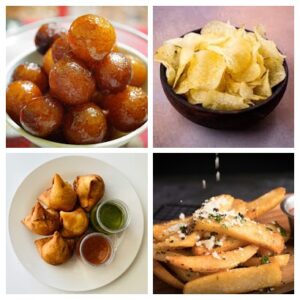 Typical deep fried items: 1. Homogeneous items like uniform batter pakaude, puries, jalebi, gulab jamuns, and potato fingers. 2. Enclosed items like samose, kachaudi, batter-coated sweets, coated veg. pakaude. Here main cooking happens to the outer covering and the enclosure merely gets partly heated with nominal moisture loss. 3. Crisps like potato chips, ‘fryums’, rice crisps where the hot oil helps trapped moisture and gases burst out. 4. Dry nuts and whole spices, which simply dry up further and, because of weak protection of evaporating water, brown and even burn up fast.
Typical deep fried items: 1. Homogeneous items like uniform batter pakaude, puries, jalebi, gulab jamuns, and potato fingers. 2. Enclosed items like samose, kachaudi, batter-coated sweets, coated veg. pakaude. Here main cooking happens to the outer covering and the enclosure merely gets partly heated with nominal moisture loss. 3. Crisps like potato chips, ‘fryums’, rice crisps where the hot oil helps trapped moisture and gases burst out. 4. Dry nuts and whole spices, which simply dry up further and, because of weak protection of evaporating water, brown and even burn up fast.
Par frying: This essentially industrial mode (mainly for export of Indian favorites) has been taken up in the next post. Paratha, samosa, coated and uncoated vegetables, pakaude, potato pieces etc. can be ‘half-fried’ to bring about the usual frying changes, wrapped in aluminium foil or parchment paper and frozen immediately. When required for consumption, they can be taken out, unwrapped and finish-fried immediately to produce a ‘ready-to-eat’ dish. The utility is obvious and so is the science behind it. First frying dehydrates and sterilizes; wrapping and freezing seals it in. Frozen storage ensures extreme slowing of all possible accidental spoilage and direct re-frying completes the fry-cooking process without moisture loss.
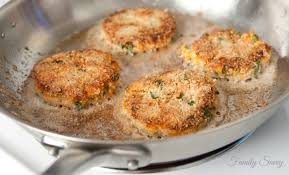 Shallow (fat) frying: There is little difference between deep and shallow frying except that the item touches the bottom of the pan and is not fully immersed. The bottom of the item is separated by only the pan bottom thickness from the flame and a thin oil film which hastens the heat transfer. Usually the item being fried is flat (patties, cutlets, fillets), low moisture (most of it, bound), heavier than oil and cannot be tossed about with a ladle because of inadequate binding. Obviously, the item needs to be inverted to complete frying. And the top and the bottom circles are browner. The firmed up semi-cooked item can tolerate careful overturning.
Shallow (fat) frying: There is little difference between deep and shallow frying except that the item touches the bottom of the pan and is not fully immersed. The bottom of the item is separated by only the pan bottom thickness from the flame and a thin oil film which hastens the heat transfer. Usually the item being fried is flat (patties, cutlets, fillets), low moisture (most of it, bound), heavier than oil and cannot be tossed about with a ladle because of inadequate binding. Obviously, the item needs to be inverted to complete frying. And the top and the bottom circles are browner. The firmed up semi-cooked item can tolerate careful overturning.
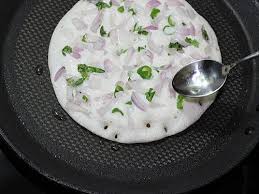 Smear oil (or thin film) frying for flat items: Paratha, omellettes, French toast, dosa, uttappam, chille (Gujarati pudla) and many regional specialities are staples in India. We will call them ‘flats’, the way the steel industry calls sheet-like products flats. Typically cooked by spreading a batter or rolled dough over smeared oil on a flat griddle or tawa. Frying is quick because of efficient heat transfer across a small thickness (short heat transfer path) and good, oil-aided thermal contact between the item bottom and griddle top skin. Despite alert smartness, browning is common. Quick turning is required and so is modulation of flame to match moisture content and brownness required. Except dosa, the moisture loss is limited and absorbed heat mainly mediates gelatinization of starch and coagulation of proteins.
Smear oil (or thin film) frying for flat items: Paratha, omellettes, French toast, dosa, uttappam, chille (Gujarati pudla) and many regional specialities are staples in India. We will call them ‘flats’, the way the steel industry calls sheet-like products flats. Typically cooked by spreading a batter or rolled dough over smeared oil on a flat griddle or tawa. Frying is quick because of efficient heat transfer across a small thickness (short heat transfer path) and good, oil-aided thermal contact between the item bottom and griddle top skin. Despite alert smartness, browning is common. Quick turning is required and so is modulation of flame to match moisture content and brownness required. Except dosa, the moisture loss is limited and absorbed heat mainly mediates gelatinization of starch and coagulation of proteins.
Important: oil also plays the role of making the griddle surface hydrophobic – important when cooking on non-nonsticks.
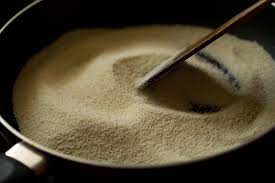 Oil-mediated roasting: South Indian Upama, Sheera or Suji halwa (popular all over India) and many flour-based sweets are roasted in a pan in presence of enough oil/ghee to cover all particles. This renders the particles hydrophobic (water repellent) and minimizes sticking when water/milk is added at a high temperature. (Now you know why the upama is lumpy when oil has been spared.) Constant, bottom-scraping stirring ensures that the flame heat is practically uniformly distributed throughout – important when the heat-absorbing presence of water is limited. (Suji or semolina and coarse chickpea flour or besan are practically dry and most of the around 10% moisture is ‘bound’.) The unnoticed fact is that oil films on particles form a continuum beginning from the bottom and heated films direct heat inward into flour particles. The changes in the flour are typical drying, caramelization and Maillard eaction and browning is common. Oil also undergoes heat-mediated changes, typically oxidation of double bonds, mostly in PUFA.
Oil-mediated roasting: South Indian Upama, Sheera or Suji halwa (popular all over India) and many flour-based sweets are roasted in a pan in presence of enough oil/ghee to cover all particles. This renders the particles hydrophobic (water repellent) and minimizes sticking when water/milk is added at a high temperature. (Now you know why the upama is lumpy when oil has been spared.) Constant, bottom-scraping stirring ensures that the flame heat is practically uniformly distributed throughout – important when the heat-absorbing presence of water is limited. (Suji or semolina and coarse chickpea flour or besan are practically dry and most of the around 10% moisture is ‘bound’.) The unnoticed fact is that oil films on particles form a continuum beginning from the bottom and heated films direct heat inward into flour particles. The changes in the flour are typical drying, caramelization and Maillard eaction and browning is common. Oil also undergoes heat-mediated changes, typically oxidation of double bonds, mostly in PUFA.
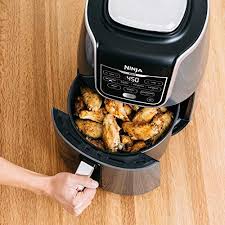 Air frying: This name has been assigned to the mode of frying in which the item is merely brushed or coated with oil and exposed to a ‘caressing’ hot air current. Since you are in control of applying oil, you feel happy about minimal oil uptake.
Air frying: This name has been assigned to the mode of frying in which the item is merely brushed or coated with oil and exposed to a ‘caressing’ hot air current. Since you are in control of applying oil, you feel happy about minimal oil uptake.
Serious points to ponder:
- In air frying, a thin oil-film exposed to a hot air current is plain hazardous even in presence of moisture evaporating thru it. Extreme care in selecting the right frying oils and controlling frying per se’ are important – something that is not emphasized by marketers to avoid ‘tainting’ their air fryers.
- As we descend the modes of frying described here, overheating and heat damage of oil is increasingly possible. The selection of oils is correspondingly more and more important, especially on iron griddles or tawa’s and on low moisture frying loads. Non-sticks do moderate these effects; you will notice that professional chefs prefer them for allowing them to chat with you while cooking. But avoid them; you can master your cooking with plain SS, carbon steel (loha) or even Aluminium vessels.
- Oils are far from being our enemies, especially when consumed smartly with a good level of physical activity. So supposedly oil-sparing methods like air frying need to be taken with a pinch of salt. Be smart in using oils; don’t give in to paranoia. Guidance on that, coming soon.
Next Post
Par frying: an interesting industrial mode of frying
And some interesting industrial edible oil products
Visit Disclaimer.
3 thoughts on “Cooking with edible oils: Part II, Cooking thru oil-mediated heat transfer”
Interesting Chemical Engineering perspective on something that is otherwise as mundane as home cooking. Upon a bit deeper reflection on articles like this one, smart cooking can possibly help avoid may life style related and other serious illnesses.
A truly thoughtful article on something that most of us, including Chemical Engineers like me, tend to ignore.
Thank you. It’s a blog. Go for its free subscription.
I truly enjoy reading on this site, it contains superb articles.